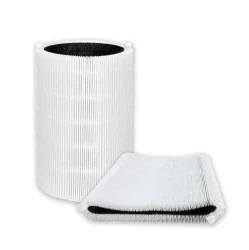Here are some common types of air purifier filters
2024-03-05
An air purifier filter is a crucial component of an air purification system, responsible for capturing and removing airborne particles, pollutants, and contaminants from the air. Different types of air purifiers may use various filter technologies to target specific pollutants. Here are some common types of air purifier filters:
1. HEPA Filters (High-Efficiency Particulate Air):
- HEPA filters are highly effective at trapping particles such as dust, pollen, pet dander, mold spores, and other airborne allergens. They can capture particles as small as 0.3 microns with a high efficiency rate, typically around 99.97%.
2. Activated Carbon Filters:
- Activated carbon filters are effective at trapping odors, gases, and volatile organic compounds (VOCs). The porous structure of activated carbon adsorbs and removes these pollutants from the air.
3. Pre-Filters:
- Pre-filters are designed to capture larger particles, such as dust and hair, before they reach the main filter. They help prolong the lifespan of other filters by preventing them from clogging with larger debris.
4. UV-C Filters (Ultraviolet-C Light):
- UV-C filters use ultraviolet light to kill or deactivate microorganisms, such as bacteria, viruses, and mold spores. While not a traditional filter, UV-C technology complements other filters by targeting biological contaminants.
5. Ionizer Filters:
- Ionizers release charged ions into the air, which attach to particles, causing them to settle. Some air purifiers combine ionizers with electrostatic filters to attract and capture charged particles.
6. Electrostatic Filters:
- Electrostatic filters use an electric charge to attract and trap particles in the air. These filters may be washable and reusable, reducing the need for frequent replacements.
7. Ozone Generators:
- Ozone generators release ozone into the air to neutralize odors and kill certain pollutants. However, they should be used with caution, as high levels of ozone can be harmful to human health.
8. Photo-Catalytic Filters:
- Photo-catalytic filters use a combination of UV light and a catalyst to break down and neutralize airborne pollutants, including VOCs and some microorganisms.
9. Antibacterial Filters:
- Antibacterial filters are designed to inhibit the growth of bacteria on the filter surface, helping to prevent the spread of bacteria and other microorganisms.
10. Molecular Sieve Filters:
- Molecular sieve filters can selectively adsorb gases and odors based on the size of the molecules, providing effective removal of specific volatile compounds.
When choosing an air purifier, it's essential to consider the specific needs of your indoor environment and the types of pollutants you want to target. Additionally, regularly replacing or cleaning the air purifier filters is crucial for maintaining optimal performance and ensuring the purification system continues to effectively clean the air. Check the manufacturer's recommendations for filter replacement intervals and follow proper maintenance procedures.



